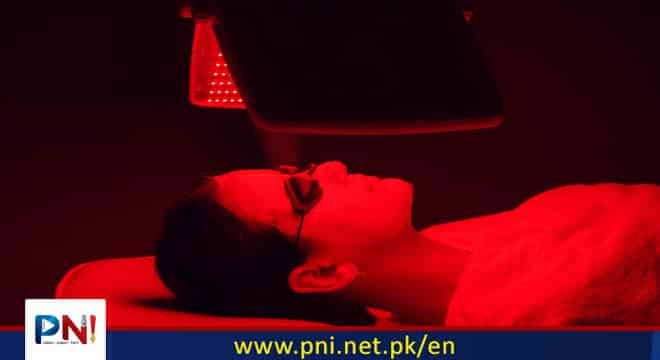ISLAMABAD, Feb 24 (Online): A new study shows red light therapy lowers blood sugar levels, which could help people with type 2 diabetes manage their condition.
Type 2 diabetes is manageable and potentially reversible through medications and lifestyle changes.
A new study has found red light therapy reduced blood sugar levels in healthy participants.
The study authors suggest red light therapy could help people with type 2 diabetes manage their condition.
As of 2021, about 537 million people around the world have diabetes, with this number expected to increase to 643 million by 2030 and 783 million by 2045.The majority of diabetes diagnoses — between 90Trusted Source% to Trusted Source95%Trusted Source — are type 2 diabetes.
Unlike type 1 diabetes, which is an autoimmune disease, type 2 diabetes is manageable and potentially reversible through medications and lifestyle changes that help a person manage their blood sugar levels.A new study recently published in the Journal of BiophotonicsTrusted Source suggests that red light therapy could help people manage their blood sugar.
While the study was conducted on people without diabetes, the study’s researchers from City University London believe this therapy could be helpful for those with the condition.
Red light therapy improves glucose metabolism
Red light therapy uses low-wavelength red light or near-infrared light that is targeted to a specific area of the body using a laser or other device.The red light can penetrate through the skin and positively impact the mitochondriaTrusted Source within the body’s cells, helping to create more energy and allowing the cells to function better and repair themselves.
Co-lead study author Dr. Michael Powner, senior lecturer in neurobiology in the School of Health & Psychological Sciences at City University London said they decided to look at red light therapy as a way to help control blood sugar levels after reading a study from 2019Trusted Source highlighting that sunlight exposure could correlate with improved glucose metabolism.
“We explored this in bumblebeesTrusted Source and found that red light reduced systemic glucose after feeding,” Dr. Powner told Medical News Today. “This latest study clearly shows a translation of this to humans.”
“Red light is absorbed by mitochondria and helps them produce more energy,” he explained.
“It lubricates the energy-making machine. But in producing more energy this way they need more raw material and this is largely glucose. They take this out of the blood.”Get Our Twice-Weekly Diabetes Newsletter
Join over 400K subscribers in receiving nutrition advice, tips on weight management, and the latest on condition breakthroughs.
How does red light therapy help with diabetes?
For this study, researchers recruited 30 healthy participants with no known metabolic conditions and who at the time were not taking any medications.
Half of the group received a 15-minute 670 nm red light treatment 45 minutes before drinking 75 grams of sugar diluted in 150 mL of water. The other half of the group also imbibed the sugar drink but received no red light therapy.
All study participants were also asked to take oral glucose tolerance testsTrusted Source and record their blood sugar levels every 15 minutes over the next two hours.
Upon analysis, scientists found that participants receiving the red light therapy reduced their peak blood sugar level and also reduced their total blood sugar levels during the two hours, compared to those not receiving the light therapy.
“It is clear that light affects the way mitochondria function and this impacts our bodies at a cellular and physiological level,” Dr. Powner said. “Our study has shown that we can use a single, 15-minute exposure to red light to reduce blood sugar levels after eating.”
“While this has only been done in healthy individuals in this paper, it has the potential to impact diabetes control going forward, as it could help to reduce potentially damaging glucose spikes in the body after meals,” he added.
Other health benefits of red light therapy
Red light therapy is most notably used as a skin treatment for reducing wrinklesTrusted Source, age spotsTrusted Source, scarsTrusted Source, and stretch marksTrusted Source.
It is also used as a treatment for skin conditions such as psoriasisTrusted Source, rosacea, acneTrusted Source, and eczema.
How much red light exposure do you need?
The study’s researchers also stated that although sunlight has a mix of red and blue light, people mainly have exposure to almost all blue light emitted from LEDs, including computer and smartphone screens.
Previous research shows that long-term exposure to blue light can be unhealthy for the body’s natural circadian rhythmTrusted Source, causing sleep issuesTrusted Source.
Other studies link too much blue light exposure to an increased risk of conditions such as:
age-related macular degenerationTrusted Source
type 2 diabetesTrusted Source
certain cancersTrusted Source (i.e., skin cancerTrusted Source and breast cancerTrusted Source)
“Going outside in sunlight helps, but ultimately we need to reduce dependence on current LEDs,” Dr. Powner said. “The old incandescent lights had a lot of red in them.”
Another reason for going outdoors
MNT also spoke with Dr. Jennifer Cheng, section chief of endocrinology at Hackensack Meridian Jersey Shore University Medical Center in New Jersey, about this study.
Dr. Cheng said she found the study interesting, but noted it was a small study with few participants.
“Additional research should be done to see if patients with abnormal glucose metabolism are affected by these ranges of light and to see if these research studies can be reproduced on a larger scale. There are many variables in the study’s participants that are not accounted for, such as body mass index and degree of adiposity,” Dr. Cheng said.
“It will be interesting to see if this is replicated and if a certain amount of sunlight is needed to help maintain glycemic control. We always encourage our patients to go outside and exercise. This is another reason to encourage outdoor activities, but it remains to be seen if the studies can be verified,” Dr. Cheng added.
According to Dr. Cheng, it’s important for researchers to continue looking for new ways to maintain glycemic control and assist those with diabetes.
“There are millions of diabetic patients in the U.S., many who are undiagnosed, and there is a significant economic burden — more than $400 billion of healthcare costs attributed to those with diagnosed diabetes,” she explained. “Medical professionals are always looking for ways to help treat those with diabetes and costless methods to mitigate effects of glycemic control.”
To help people keep blood sugar — blood glucose — within a healthy range, the American Heart Association (AHA)Trusted Source recommends:
engaging in weight management
eating a nutritious diet
getting regular exercise
stopping smoking
reducing stress
If making dietary and lifestyle changes do not help maintain a healthy blood sugar level, doctors may adviseTrusted Source a person to take medications. However, if someone receives a diabetes diagnosis as an older adult and their blood sugar is only mildly elevated, medications may not be necessary.
In this article, we examine how to control type 2 diabetes without medication. We also look at the causes of type 2 diabetes and when people may need medication to manage their condition.







